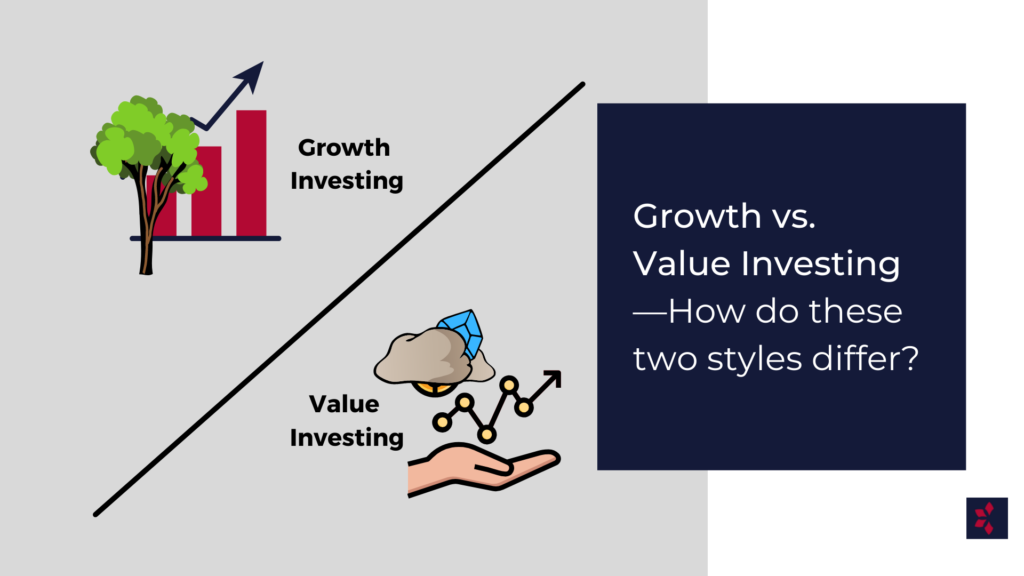Growth vs. Value Investing—How Do These Two Styles Differ?

Two of the most common investing styles are growth investing and value investing. These styles can be at the opposite ends of the stock selection spectrum: to select a growth stock, investors look for companies that have current and future earnings growth potential; to select a value stock, investors look for stocks that based on their analysis are currently undervalued. What is the difference between growth and value stocks, what are some potential investor biases for each, and is one style ultimately better than the other?
Growth Stocks Explained
Stocks identified as growth tend to be shares in companies that are expected to grow at a faster rate than that of the general market. As such, growth companies can be found in emerging growth industries or in historically rapid growth industries such as technology.
- Growth stocks may have higher relative valuations and price volatility due to investor expectations of future higher sales or profits, and if these do not materialize, the price drops accordingly.
- Growth stocks typically do not pay dividends—earnings are usually reinvested into the company to finance future growth. It’s important to note while growth investors may argue that dividend-payers are less exciting, paying dividends does not make a company “slow-growth.”
Optimally, growth investors look to invest in companies with greater future earnings growth relative to the company’s industry sector and the general market.
Potential Growth Investor Biases:
- Investors believe that a high earnings growth history indicates the company may be able to continue to produce high earnings levels even during periods of slower economic improvement.
- Investors are willing to accept greater short-term stock price volatility for the potential long-term reward of greater future growth.
- Investors are willing to pay high price-to-earnings multiples with the expectation of selling them at even higher prices as the companies grow.
Value Stocks Explained
Value stocks can be found in most industry sectors. These stocks trade at a price lower than their intrinsic value. They could be shares in new companies that have not yet been discovered by the market or existing companies that have fallen out of market favour but still maintain their underlying value—these stocks may have the potential to increase in price to reflect the company’s actual value.
Optimally, value investors look to invest long-term in value stocks that are undervalued but also have the potential to increase revenues when the market corrects the price.
Potential Value Investor Biases:
- Investors expect that the stocks of good companies will eventually rise in price when the market recognizes the companies’ intrinsic value.
- Investors believe that current undervaluation relative to similar companies or the market is due to overreaction by investors to a company’s negative announcement or to an overall industry downturn which will eventually correct.
- Investors hold stocks long-term as long as fundamentals support the actual underlying value of the company.
How to Identify a Growth vs. Value Stock?
Growth stocks may be exemplified by tech companies such as Apple or Microsoft (especially in their start-up phase) and value stocks are often represented by companies that have lagged their industry peers for non-fundamental reasons.
While some stocks will almost always be categorized as either growth or value, it can also be the case that the same stock is held by both growth and value managers. This can be especially true after a significant broad market decline where even high-growth companies may be undervalued relative to their intrinsic value.
Fundamental Characteristics used to Differentiate Growth Stocks from Value Stocks:
| Growth | Value |
| Higher P/E (Price/Earnings) | Lower P/E (Price/Earnings) |
| Higher P/B (Price/Book) | Lower P/B (Price/Book) |
| Faster Earnings Growth | Slower Earnings Growth |
| No (or low) dividend yields | Higher dividend yields |
Is Growth Investing Better than Value Investing, or Vice Versa?
The growth investor places a significant amount of emphasis on forward looking revenues as some growth companies may not have earnings in their first several years—stock price appreciation comes from future growth of the company.
The value investor looks at a company’s value relative to where it has traded in the past, where its comparables are currently trading and what multiple of earnings the company could trade at to justify its stock purchase.
With that said, is one investment style ultimately better than the other?
This has been the historical debate since the inception of investment management and the evolution of equity selection styles going back to Benjamin Graham’s 1949 investment manifesto “The Intelligent Investor.”
Graham differentiated the value investment proposition supported by fundamental analysis and played a significant role in shaping the investment philosophy of Warren Buffet, one of the most famous of value investors who stated, “In the business world, the rear-view mirror is always clearer than the windshield.”
However, Peter Bernstein, an American financial historian, economist and educator and a proponent of growth investing, said “Past corporate successes are only frail guides to future good fortune.”
As you can see, the answer is that each investment management style can be successful if applied diligently over the long-term!
This content is provided for general informational purposes only and does not constitute financial, investment, tax, legal or accounting advice nor does it constitute an offer or solicitation to buy or sell any securities referred to. Individual circumstances and current events are critical to sound investment planning; anyone wishing to act on this content should consult with his or her financial partner or advisor.